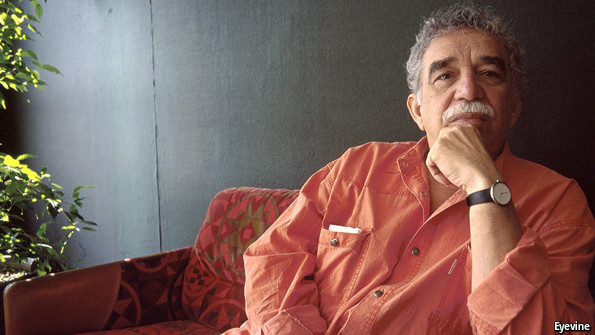
IN JULY 1965 Gabriel García Márquez—Gabo to all who revered him later—decided to lock himself away in a house on Calle de La Loma in Mexico City. He ordered his wife to sell the car and get credit from the butcher. For 15 months, using only his index fingers, he typed for six hours a day in a room he called “The Cave of the Mafia”. He survived on a diet of good Scotch and constant cigarettes. At five in the afternoon he would emerge into the fading light with his eyes wide, as though he had discoursed with the dead.
Inside the four walls of that room lay the immense delta of the Magdalena river, the grey frothy sea of Colombia’s Caribbean coast, the suffocating swamps of the Ciénaga, the interminable geometries of the banana plantations, and a long railway line that ran into the farthest territories of his heart. It ended at the village of Aracataca, now renamed by him Macondo, where his maternal grandparents had brought him up amid prospectors, fornicators, gypsies, scoundrels and virginal girls bent over their sewing frames. In that room where he had locked himself away he inhaled the sweet milk-candy and oregano of his grandmother and absorbed again the political venting of his grandfather, who had fought on the Liberal side in the War of a Thousand Days and who, at the book’s beginning, took him to discover ice, a great block of infinite internal needles that boiled his hand when he touched it.
“One Hundred Years of Solitude”, the fruit of his self-imprisonment, sold 50m copies in more than 30 languages. Critics observed that its style, magical realism as they called it, was not new: Jorge Luis Borges, a blind Argentine poet, had felt his way through those labyrinths before. But its fame was startling. The world was seduced by a Latin America where the Buendía family feuded internally and externally, with rifles or with silence, for generations; where death gave its female victims instructions to sew their own shrouds; where the blood from a suicide by shotgun flowed all through Macondo, carefully avoiding the carpets; and where Remedios the Beauty was taken up to heaven as she hung out sheets on the washing line.
And it was all true. So Gabo insisted, to those who found his world outmoded and impossible. What seemed fantastical and extraordinary was merely reality in its local guise. Between novels he kept up his first profession, journalism, fearlessly reporting government scandals and narcoterrorism. When he had become hugely famous the government of Colombia sent him to mediate with the FARC guerrillas. That was surely as surreal as anything he wrote in the house on Calle de La Loma.
What the world could not grasp about Latin American literature, he told his Nobel prize audience in 1982, was the presence in it of the ghosts of the disappeared, as many as the population of Uppsala, and of émigrés and exiles, as many as there were Norwegians. These shadows, with their different reality, were as persistent as the continent’s beauty, its violence and its pain. In the year after he was born a crowd of banana workers, their number as fluid and fleeting as memory, were killed by the army in Aracataca, the bodies taken so silently by train to the coast that the story at once became myth. It grew with him.
His sympathies stayed on the left-Liberal side of things. Under General Rojas Pinilla Colombia became uncomfortable; he took refuge in Mexico in 1961, and for years was refused entry to the United States. Fidel Castro and Hugo Chávez were proud to count themselves his friends. With Mr Castro he went fishing and talked books, he said, not politics. But he had a weakness for the “halo of power”, of whatever colour, and a soft spot for old autocrats still carrying, like Simón Bolívar in “The General in his Labyrinth”, their bullet scars, their memories of past glories and their faded battle tunics, with buttons made from the gold of Atahualpa.
Writing was difficult; the words came as painfully as kidney stones. Nonetheless, there was nothing else he had wanted to do in life. He burned “to write so I would not die”. The desire began with “The Thousand and One Nights” in childhood and the tale of the fish, slit for frying, with a diamond as big as an almond in its belly. It was reinforced in his cub-reporter-student days in the cafés of Barranquilla and Cartagena, where he discovered Kafka, Faulkner, Woolf and Hemingway. His strongest influence, though, remained his grandmother, who had told him with the most deadpan face that the strangest things were true.
Taking the steamboat
Those tales assumed no division between the waking and dreaming state. Like him, his characters were often insomniacs, terrified of the dark and plagued, as he was, by intrauterine memories and premonitory dreams. Their affliction was so acute that their days became seamless and infinite as winter rain. Yet his lovers too, in sheer happiness, were in the same suspended state. His last substantial novel, “Love in the Time of Cholera”, based on the forbidden romance of his own parents, ended with the aged lovers on the creaking Magdalena steamboat, pushing through purple lotus and past crocodiles with their mouths agape to catch butterflies, out to the mouth of the sea. But as his grandfather had told him, when they first saw that horizon, “There is no shore on the other side.”
